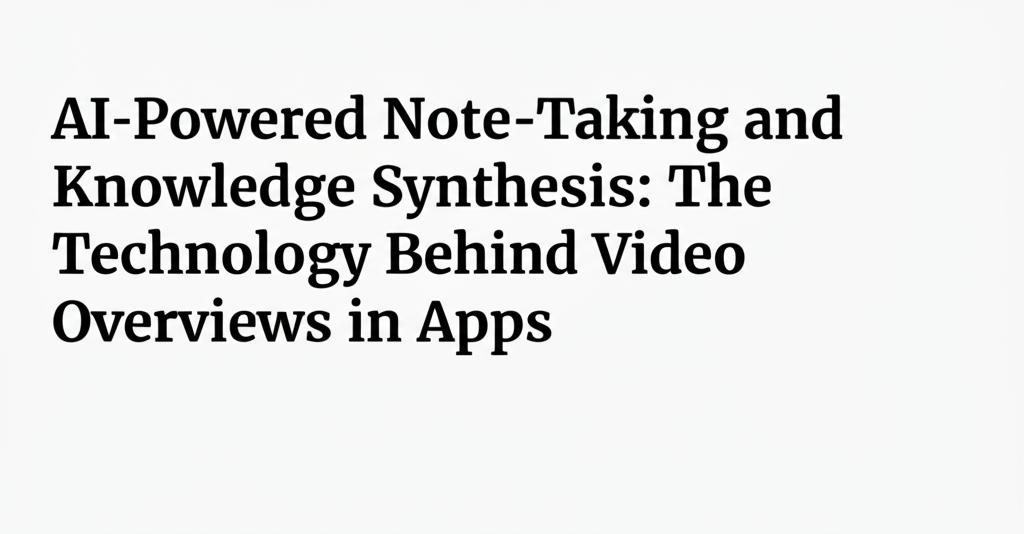The way we interact with video content is rapidly changing, and AI-powered note-taking and knowledge synthesis are at the forefront of this transformation. Apps incorporating these technologies are offering users unprecedented efficiency in understanding and utilizing video information. This shift is driven by sophisticated AI, including machine learning models and natural language processing (NLP), which work in concert to analyze, summarize, and organize video content.
At its core, AI-powered video analysis involves several key technological components. Speech recognition transcribes the audio from videos into text. This transcribed text then becomes the foundation for further analysis. Natural Language Processing (NLP) algorithms are then employed to make sense of this text. NLP techniques like named entity recognition (identifying key people, places, and organizations), topic modeling (discovering the main themes), and sentiment analysis (gauging the emotional tone) are crucial for understanding the context and importance of the information presented in the video.
Machine learning (ML), particularly deep learning models, plays a vital role in identifying key moments and themes within the video. These models, including neural networks like Convolutional Neural Networks (CNNs) for visual analysis and Recurrent Neural Networks (RNNs) or transformer-based models (like BERT and GPT) for language understanding, are trained on vast datasets to recognize patterns and extract meaningful information. Some systems use multimodal AI models that can process and integrate information from various sources simultaneously, such as audio, visual elements, and text, leading to richer and more contextually aware summaries.The process of creating video overviews generally follows these steps:
- Video Ingestion: The user uploads a video file or provides a link to a video (e.g., from YouTube or Vimeo).
- Content Processing: The AI analyzes both the audio and visual components. This includes speech-to-text transcription and visual analysis to detect scenes, objects, and sometimes even on-screen text using Optical Character Recognition (OCR).
- Key Information Extraction: Using NLP and ML, the system identifies crucial segments, keywords, main topics, and important dialogue. Techniques like keyframe extraction (selecting representative still frames) and scene detection (identifying changes in scenes) help in breaking down the video into manageable parts.
- Summarization: Based on the extracted information, a summary is generated. This can be extractive, meaning it selects the most relevant segments from the video and compiles them, or abstractive, where the AI generates new sentences to summarize the core content, much like a human would. Some advanced systems employ reinforcement learning, where AI agents learn to create optimal summaries by interacting with the video content and receiving rewards based on the summary's quality.
- Note Generation and Organization: The AI generates comprehensive notes, often organized by topics, timestamps, and key points. Users can then review, edit, and customize these notes.
The benefits of this technology are manifold. For students, it means turning lengthy lecture recordings into structured study guides. Professionals can quickly catch up on missed meetings, webinars, or training sessions. Content creators can repurpose long-form video into blog posts or social media snippets. Researchers can efficiently extract insights from interviews and presentations.
Modern AI note-taking apps often include advanced features such as:
- Interactive Summaries: Clickable timestamps allow users to jump directly to relevant parts of the video.
- Topic Clustering: Related points are grouped for better clarity and understanding.
- Multilingual Support: Transcription and summarization are available in multiple languages.
- Sentiment Analysis: The AI can detect the overall tone of the video.
- "Chat with your video": Users can ask questions about the video content and receive precise, timestamped answers.
- Key Moment Screenshots: The ability to capture and add visual snapshots to notes.
- Integration with other tools: Exporting notes and summaries to platforms like Notion streamlines workflows.
The accuracy of these AI systems is continually improving, with some platforms claiming over 95% accuracy for clear audio. They can often recognize multiple speakers and technical terminology. While challenges such as handling diverse accents, background noise, and poor audio quality remain, advancements in noise cancellation and speech recognition technology are steadily addressing these issues.
The future of AI in video summarization and note-taking points towards even more sophisticated capabilities, including real-time summarization of live events, deeper contextual understanding, and more personalized learning experiences. As AI models become more powerful and nuanced, the ability to quickly distill vast amounts of video information into actionable knowledge will become increasingly seamless and integrated into our digital lives.

